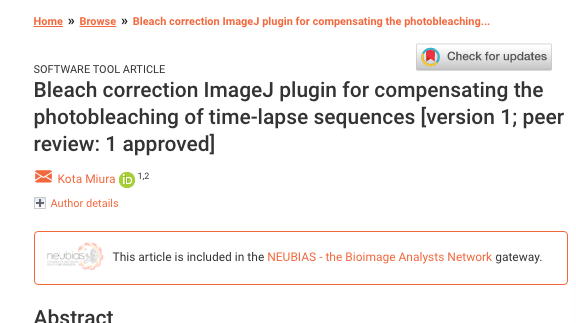
- HOW TO REFERENCE IMAGEJ SOFTWARE IN A PAPER HOW TO
- HOW TO REFERENCE IMAGEJ SOFTWARE IN A PAPER INSTALL
The main usage of the ND plugin is to analyze the size and spacing of particles/pores/tubules located randomly in a sample. Measurement of tubule/fiber diameter and their spacing in tubular scaffolds or fiber reinforced composites
HOW TO REFERENCE IMAGEJ SOFTWARE IN A PAPER HOW TO
Messages will be displayed in case any of the above conditions are not met and users will be directed on how to proceed. The user may run Analyze -> Analyze Particles built-in Plugin to generate a Results table needed by the ND Plugin. (Centroid and Fit ellipse must be checked under Analyze -> Set Measurements). Prior to running the ND plugin, an image should be opened first and the Results table must have records including centroid coordinates of the particles that need to be analyzed. Alternatively, the already compiled file (ND_.class) can be downloaded and placed in the Plugin folder of ImageJ installation. The ND_.java file should be compiled for the first time using Plugins -> Compile and Run ….On restarting ImageJ, the plugin will appear under the menu Plugins. ND_.java file should be downloaded to the plugins folder of the ImageJ installation.
HOW TO REFERENCE IMAGEJ SOFTWARE IN A PAPER INSTALL
To install the plugin, ImageJ must be installed first. The number of neighbors to be accounted for in calculating the averages is set by the user. The plugin uses an image of the sample as input and outputs a result table listing the average distance of each particle from its neighbors, nearest neighbor distance, and the average wall thickness of its neighbors. The main usage of the ND plugin is to analyze the wall thickness and average spacing of particles/pores/tubules located randomly in a sample. ND is an example of a specialized plugin that builds upon the built-in functionalities of ImageJ, and contributes to the collective efforts to enrich its library of available plugins and advances its versatility in image processing. Although ImageJ is taking center stage as a reliable open source and user-friendly tool for image processing in the biomedical field, image analysis is done either manually or by using propriety software associated with microscope companies or other commercial software whenever specialized plugins for ImageJ are not available.

Therefore, characterization of fabricated scaffolds using microscopy techniques and subsequent processing of the images is an essential step in correlating a specific cell-scaffold response with an effective scaffold design.

The architecture of the porous scaffolds including pore size distribution and density dramatically affects their interaction with biological cells and mechanical properties of the scaffold. ND, which stands for nearest distances, is an ImageJ plugin that was developed to calculate the average size and distance between pores and their nearest neighbors in a porous scaffold by using images of the scaffold as input.


 0 kommentar(er)
0 kommentar(er)
